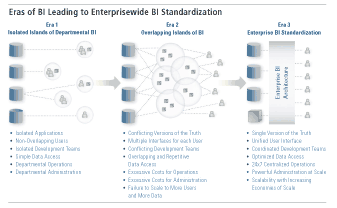LESSON - Migrating to the New Era of Business Intelligence
By Megan Lordeon, Senior Manager, Strategic Marketing, MicroStrategy

Many IT executives, business leaders, and CIOs are increasingly dissatisfied with their overall business intelligence capability. They are not satisfied with simply providing some information to some users. These leaders want to open up their ever-growing data assets to all of the people across the organization, and do so in a cost-effective and scalable way. They are now demanding that their business intelligence technology deliver on this ideal. MicroStrategy shares this vision.
In recent decades, businesses have approached their BI solutions and implementation in varying ways. Some companies started with departmental BI with information silos or islands. Most companies have since moved to the second era of BI implementation, characterized by overlapping disparate islands, and are suffering high user dissatisfaction and excessive IT effort. Today, companies are selecting a BI solution that is built for the long term, with fully integrated and functionally complete architecture. Among these approaches, three eras of BI implementation have surfaced as businesses evolve.
Era 1
Isolated Departmental Islands of BI Were an Initial Success
Over the past decade, most companies have deployed BI applications as departmental solutions and have accumulated a large collection of disparate BI technologies as a result. Each distinct technology supported a distinct user population and database within a well-defined “island of BI.” At first, these islands of BI satisfied the early needs of the business, but early success in departmental deployment sowed the seeds for new problems as the applications grew.
Era 2
Overlapping Disparate Islands of BI Have Become a Major Liability
Successful applications always expand. The second era is hallmarked by BI applications that have expanded to the point where they are no longer isolated islands. Instead, they overlap in user populations, in data access, and in analytic domain. As a result, CIOs are now faced with an untenable situation. The enterprise is getting conflicting versions of the truth. The quickly growing business user population is distinctly unhappy about being forced to use multiple different BI tools. Departmental BI tools hit scalability limits. The CIO is wrestling with an ever-accelerating maintainability burden to keep all of these disparate systems synchronized.
Era 3
Enterprise BI Standardization Requires a BI Architecture that Is Fully Integrated, Functionally Complete, and Industrial Strength
The new era of business intelligence is one where a single BI architecture delivers a single version of the truth through a unified user interface to all people in the enterprise. It can access all of the data, administer all of the users uniformly, eliminate the repetitive data access, reduce the administrative effort, and reduce the time to deploy new BI applications. Such a BI architecture must exhibit three dominant characteristics to fulfill this role. First, it must be a truly integrated architecture to achieve economies of scale. Second, it must offer the full range of BI functionality currently delivered by the myriad of departmental BI products so that it can adequately replace them. And third, it must be “industrial strength” so that companies can confidently deploy applications across the enterprise and at enterprise scale.
World-class companies in every industry leverage the strength of MicroStrategy BI to centralize their business intelligence functions in a “BI center” capable of supporting thousands of users with even greater efficiency than it supports hundreds of users. MicroStrategy was designed to operate with rock-solid, 24x7 performance, minimal effort, and on a worldwide scale if needed.
MicroStrategy ushers in a new era of business intelligence, one where any business user can access any data, located anywhere in the enterprise. MicroStrategy’s unified BI architecture meets modern scalability challenges head-on, allowing thousands of business users to simultaneously access terabytes of data with mission-critical reliability. Only the MicroStrategy architecture was designed from the ground up as an integrated architecture suitable for enterprisewide BI standardization.
This article originally appeared in the issue of .